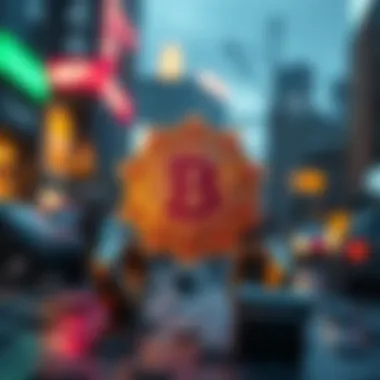Navigating the NFT Business Environment


Intro
As the digital realm continues to burgeon, new avenues are emerging that challenge traditional concepts of ownership and value. Among these, the non-fungible token (NFT) space stands out, presenting both vast opportunities and complex challenges for investors and creators alike. This article dives into the intricate mechanics of the NFT business landscape, breaking down core principles and elucidating market trends that are reshaping the digital asset universe. Whether you’re a seasoned investor, an aspiring creator, or simply curious about this innovative framework, you’ll find valuable insights that highlight the multifaceted nature of NFTs.
Understanding Cryptocurrency
The bedrock of NFTs lies in blockchain technology, fundamentally intertwined with cryptocurrency. While many have heard the term „cryptocurrency“ batted around like a ping-pong ball, understanding its essence is vital for grasping the NFT environment.
What is Cryptocurrency?
Cryptocurrency is essentially a digital or virtual form of currency that employs cryptography for security. This decentralization offers an alternative to traditional banking systems. The best-known example is Bitcoin, which revolutionized how we think about financial transactions.
Key Components of Cryptocurrency
In breaking down cryptocurrency, a few key elements emerge:
- Decentralization: Unlike conventional currencies, cryptocurrencies are not governed by a central authority. This could mean fewer regulations but also added responsibility on the user.
- Blockchain Technology: This is the underlying structure that records all transactions across a network of computers. It enables transparency and security, which are vital for trading NFTs.
- Tokens vs. Coins: Coins typically represent a base currency like Bitcoin, while tokens can signify assets or can be used for specific functionalities within an ecosystem. NFTs, in particular, are a form of tokens tied to digital assets, granting proof of ownership.
Navigating the Market
As the NFT market continuously evolves, it is crucial for potential investors and creators to stay abreast of emerging strategies and trends. Conversations surrounding NFTs are not merely academic; they possess tangible implications for market participants both in the short and long term.
Investment Strategies and Tips
For those looking to dive into NFT investments, armoring yourself with the right strategies can make all the difference. Here are a few considerations:
- Research: Understanding the project, the team behind it, and its potential longevity is paramount. Each NFT is tied to a unique asset; knowing its backstory and projected value trajectory can guide investment decisions.
- Community Engagement: Being active in platforms such as Discord or Reddit can provide insights not just from developers but also from fellow investors who share experiences and strategies.
- Diversification: Just like any investment portfolio, spreading risk across various assets can mitigate loss. Consider investing in a mix of established artists and emerging creators.
Analyzing Market Trends
Market dynamics can shift as quickly as sand through an hourglass. Keeping an eye on trends helps investors align their strategies more effectively. Some notable trends currently shaping the landscape include:
- Cross-platform functionality: NFTs proving usable across various blockchain platforms are gaining popularity, indicating a shift toward interoperability.
- Utility beyond art: NFTs are creeping beyond digital art into sectors like music, gaming, and even virtual real estate, showcasing their versatility.
- Environmental considerations: With growing concerns over the carbon footprint of blockchain operations, sustainability has become a talking point among investors and creators, influencing purchasing decisions.
"In the jungle of the NFT marketplace, knowledge is one’s best mate; it’s navigating the terrain that reveals the opportunities hidden away.”
As you delve deeper into understanding NFTs and their market standing, remember:
- Diligence is the key to success.
- Always* be aware of evolving trends that can impact value.
By engaging with the material presented in this article, you're equipping yourself to navigate this innovative landscape with a discerning eye and informed mind.
Prolusion to NFTs
In the rapidly changing landscape of digital assets, the significance of Non-Fungible Tokens (NFTs) cannot be overstated. As a new form of digital ownership, NFTs are redefining the way we perceive value and ownership in the online world. This section aims to establish a foundational understanding of NFTs, which is crucial for any investor, educator, or tech enthusiast looking to navigate this intricate space.
Understanding NFTs is like holding a mirror to the evolution of art, collectibles, and even personal identities online. The way people buy, sell, or trade these tokens marks a significant departure from conventional asset management and ownership principles.
- Unique Ownership: NFTs allow individuals to own a unique piece of digital content, be it art, music, or even virtual real estate, effectively changing the narrative of digital assets as merely replicable and infinite.
- Market Relevance: Recognizing the role of NFTs in creating a bridge between creators and consumers, this market has become a playground of innovation and investment opportunities.
- Considerations for Investors: While the allure of NFTs is significant, understanding the inherent risks, such as market volatility and environmental concerns, is essential for informed decision-making.
In short, diving into the world of NFTs offers both risks and rewards, and the ability to grasp these concepts could be a game changer for various stakeholders.
Defining NFTs
NFTs, or Non-Fungible Tokens, are digital assets that represent ownership of a unique item or piece of content. What sets them apart from cryptocurrencies like Bitcoin is their lack of interchangeability. Simply put, one Bitcoin is always worth the same as any other Bitcoin, while an NFT holds distinct qualities, making it one of a kind. Think of it as a digital fingerprint - it cannot be replicated.


These tokens exist on blockchain technology, which acts as a decentralized ledger ensuring their authenticity and uniqueness. You might find NFTs in various forms, such as artworks, trading cards, music files, or even tweets. Each NFT comes with metadata that links it to the specific asset, giving buyers and sellers the confidence in its provenance.
Historical Context and Evolution
The origins of NFTs can be traced back to the early days of blockchain technology, but they started gaining significant attention around 2017 with projects like CryptoKitties. This game allowed users to breed and trade digital cats, showcasing the potential of NFTs in a playful, engaging manner.
Over the years, numerous platforms have emerged, broadening the scope and understanding of NFTs. Artists and creators have turned to NFTs to monetize their work, bypassing traditional galleries and auction houses. This paradigm shift not only democratizes access to art but also provides a more equitable revenue model for creators.
The evolution of NFTs has also led to larger discussions about copyright and digital ownership, which raises questions about the implications for content creators and consumers alike. As the market for NFTs expands, so do the complexities surrounding their use and the laws governing ownership.
As the NFT landscape continues to evolve, understanding its historical context provides valuable insights into current trends and future opportunities.
The Mechanisms Behind NFTs
Exploring the mechanisms behind NFTs is essential for grasping their role in the digital economy. It uncovers how these digital assets operate within the broader blockchain framework and what makes them unique. The following sections delve into fundamental aspects like blockchain technology and the minting process, revealing their contributions and implications for creators, collectors, and investors alike.
Blockchain Technology
Decentralization
Decentralization is a cornerstone of blockchain technology. At its heart, it refers to the absence of a central authority managing transactions. Instead, a network of computers collectively maintains the system. This structure fosters transparency and trust, as no single entity holds sway over the data. It empowers users by giving them more control while lessening the risk of manipulation.
One significant characteristic of decentralization is its ability to eliminate intermediaries. In traditional frameworks, artists often rely on galleries or auction houses to sell their works, losing a hefty portion of their profits in commissions. With NFTs, creators can sell directly to consumers, ensuring a fairer revenue distribution.
However, decentralization isn't devoid of drawbacks. The absence of oversight can also lead to issues like fraud or misinformation, making due diligence necessary for all parties involved in NFT transactions. In summary, decentralization brings an empowering shift in control, albeit not without its challenges.
Immutability
Immutability, in the context of blockchain, refers to the irreversible nature of data once it is recorded on the network. This characteristic ensures that once an NFT is minted, its ownership and transaction history cannot be altered. The permanence of blockchain records is a vital part of what makes NFTs appealing to investors and collectors.
The key advantage of immutability is trust. Users can be assured that the data regarding ownership is accurate, drastically reducing disputes over authenticity. This quality positions NFTs securely in the art market, as buyers are more inclined to invest in pieces they know are verifiable.
However, the flip side is that mistakes can't be easily rectified. If an NFT is minted with erroneous information, correcting it becomes a complex issue, leading to potential confusion and loss of value. Despite this, immutability serves as a solid foundation for credibility in the NFT ecosystem.
Smart Contracts
Smart contracts are self-executing contracts with the terms of the agreement between buyer and seller written into code. They run on the blockchain and automatically execute actions, such as transferring ownership once certain conditions are met. This makes them indispensable in the NFT landscape, simplifying transactions and ensuring security for both parties.
A standout feature of smart contracts is their ability to enforce royalty payments. For instance, if an NFT is resold, the original creator can receive a percentage of the sale automatically, creating a sustainable revenue model. This approach nurtures ongoing relationships between creators and collectors and is a significant reason many artists have embraced NFTs.
However, smart contracts are only as good as the code they’re based on. Vulnerabilities in the code can open doors to potential exploits, causing significant risk in transactions. Still, the efficiency and assurance that smart contracts provide highlight their importance in the thriving NFT business.
Minting Process
Reserved for next section.
Types of NFTs
The realm of NFTs is as varied as it is vibrant, with each type offering unique advantages and engagement methods. Understanding the different types of NFTs is crucial for anyone looking to navigate this intricate landscape. They help illustrate how versatile these digital assets can be, from providing artists with new revenue streams to revolutionizing gaming experiences. It's essential to grasp these distinctions as they not only cater to different audiences but also set the stage for future innovations.
Art and Collectibles
Art and collectibles NFTs represent a significant portion of the market, combining creativity with technology. When artists mint their work as NFTs, they often find themselves entering a new world of potential income without the traditional constraints of galleries or exhibitions. Digital artists like Beeple have expertly harnessed this phenomenon, creating multimillion-dollar sales that have caught the eye of collectors and investors worldwide.
Examples include:


- Art Blocks: This platform allows artists to create generative art, where the final product is determined by algorithms, resulting in unique pieces.
- CryptoPunks: One of the earliest NFT projects, these pixelated characters have become icons of the NFT movement, fetching millions at auctions.
However, there are considerations. The market's volatility can be daunting, leading some to question the long-term value of digital art compared to physical counterparts. Additionally, ethical concerns about copyright and ownership persist, making it essential for buyers to do their diligence before purchasing.
"With each NFT purchase, collectors don't just buy art; they invest in the creator's vision and legacy."
Gaming Assets
Gaming assets represent another dynamic segment of the NFT ecosystem. Here, players can own, trade, and sell in-game items that they carefully curate through gameplay. This shift has led to a more engaging user experience; players are no longer just consumers but active participants in a digital economy.
Notable instances include:
- Axie Infinity: Players breed and battle creatures, with the ability to sell them as NFTs.
- Decentraland: An expansive virtual world where users can buy, sell, and develop parcels of land, all represented as NFTs.
These assets provide players with a sense of ownership that traditional gaming lacks. Yet, challenges remain. Game developers hold power in controlling the market, and players risk losing everything if a platform shuts down. Furthermore, there’s a potential for market manipulation, making transparency crucial for fostering trust.
Music and Media
In the music industry, NFTs are shaking things up in unprecedented ways. Musicians are discovering that they can directly connect with fans through unique audio experiences. Selling music as NFTs allows artists to create exclusive albums, concert tickets, or even behind-the-scenes content, offering fans something truly special.
For example:
- Kings of Leon released an album as an NFT, including exclusive artwork and front-row concert tickets, which was revolutionary.
- Audius: This decentralized music streaming platform leverages blockchain technology to help artists earn more from their music.
Despite the excitement, the NFT music landscape is not without hurdles. Copyright and licensing remain complex issues, and artists must navigate these waters carefully to avoid potential legal pitfalls. Furthermore, the environmental impact of blockchain technologies, particularly in music streaming, raises serious questions about sustainability.
Understanding these types of NFTs not only allows investors and creators to identify opportunities but also highlights the transformative power they're wielding across different sectors. By grasping their potential and pitfalls, stakeholders can make informed decisions that align with their goals.
The NFT Marketplace
The NFT marketplace serves as a pivotal element in the broader NFT business landscape, acting like a bustling bazaar for digital assets. This environment not only facilitates the buying and selling of NFTs but also influences trends, pricing, and availability of various digital items. With myriad platforms available, navigating this space can be daunting for creators, investors, or casual collectors. However, understanding these marketplaces is crucial for anyone engaging with NFTs.
Major Platforms
Several platforms dominate the NFT marketplace, each offering distinctive features and functionalities that cater to different users. Let's dissect a few significant ones:
OpenSea
OpenSea stands as one of the first and largest NFT marketplaces. This platform prides itself on its user-friendliness and vast inventory, allowing users to buy, sell, and auction digital goods ranging from art to virtual real estate. Its key characteristic is the decentralized nature, meaning that users retain control over their assets without a central authority. OpenSea's ability to aggregate various categories of NFTs in one place has made it a go-to platform for many in the NFT ecosystem.
One unique feature of OpenSea is its royalty system, where creators can earn a percentage every time their NFT is resold. This creates a win-win situation: creators can benefit from future sales while buyers can invest in unique digital assets. However, some users have raised concerns regarding transaction fees that might cut into profits, especially for small-scale creators and collectors.
Rarible
Rarible is another notable player in the NFT marketplace, emphasizing a community-driven approach. Unlike other platforms, Rarible introduces the concept of decentralized governance, meaning users can vote on various decisions such as featured listings and platform upgrades. This democratic ethos appeals to many users who seek transparency and involvement in platform direction.
A standout characteristic of Rarible is the ability to create NFTs without extensive programming knowledge. This simplifies the minting process and opens the door for artists and creators of all backgrounds. One downside to consider is that the popularity of Rarible has led to an influx of content, which may lead to saturation, making it challenging for individual works to rise above the noise.
Foundation
Foundation is an invitation-only NFT marketplace, often associated with curated digital art. This exclusivity promotes a sense of quality and community among a select group of creators, making it particularly attractive for artists aiming to establish themselves in the NFT space. The platform focuses on building relationships between artists and collectors, fostering a supportive environment.
A defining feature of Foundation is its emphasis on collaborative projects. Creators can collaborate to release limited editions, enhancing the exclusivity factor. However, being invitation-only can be a barrier for emerging artists wanting to break into the market, as getting an invite might prove challenging without prior connections.
Market Trends


The NFT marketplace is a rapidly evolving terrain that reflects broader trends in technology and culture. Key trends like the rise of play-to-earn models in gaming, increasing interest in virtual real estate, and the growing integration of NFTs in social media platforms indicate a future where these digital assets could play a central role in both commerce and personal expression. It's a space where traditional boundaries are blurred, allowing for innovative business models.
"The NFT marketplace is where creativity meets technology, resulting in an ever-changing landscape for digital assets."
Investors should stay vigilant, constantly researching to adapt to shifts in consumer behavior, marketplace dynamics, and emerging technologies influencing this quickly shifting environment. Understanding the specific platforms and trends will be crucial for navigating the NFT business effectively.
Legal and Regulatory Considerations
The conversation surrounding legal and regulatory considerations in the NFT business is paramount, as navigating this landscape is essential for creators, investors, and collectors alike. Understanding these factors not only shapes the way individuals engage with NFTs but also how businesses operate within this innovative yet complex sector. Legal issues can often seem like a maze; therefore, being well-informed can help avoid pitfalls. This section delves into two main components: copyright issues and tax implications.
Copyright Issues
When it comes to NFTs, copyright law plays a crucial role. Unlike physical art, where ownership transfers with purchase, NFTs raise questions about who really owns the underlying digital asset. The creator of a digital file retains copyright unless they explicitly transfer it. This means even after purchasing an NFT, the buyer may not possess the right to reproduce or commercially exploit the image or item unless specified.
Consider the example of a digital artist who mints an NFT. When a collector buys this NFT, they receive a token that certifies their ownership of that specific digital artwork. However, if the artist hasn’t waived their copyright, they could still sell prints or reproduce the artwork in various forms, essentially retaining certain rights.
"Ownership of an NFT does not necessarily convey copyright over the underlying digital asset."
For buyers and investors, understanding the scope of copyright is essential. Without it, one might inadvertently infringe on the creator's rights, opening doors to legal disputes. This lack of clarity can also hinder the NFT market's growth; if artists feel their rights are not adequately protected, they may hesitate to enter the space. Thus, familiarizing oneself with copyright law is not just an academic exercise—it is vital for navigating the NFT marketplace.
Tax Implications
Tax implications present another layer of complexity. NFTs can be treated as property for taxation purposes in many jurisdictions. This means that any gain from selling an NFT could be subject to capital gains tax. This can become problematic, especially for frequent traders who might find themselves liable for significant taxes depending on how often they buy and sell.
For instance, if an investor purchases an NFT for a thousand dollars and sells it later for two thousand, that one thousand dollar profit could be taxed. During rapid market fluctuations, identifying the proper time to buy or sell can become a tangled web—not only affecting the financial outcome but also the tax reporting obligations.
In addition, some countries have regulations regarding cryptocurrency transactions that may extend to NFTs. Investors would be wise to keep meticulous records of their transactions to comply with tax obligations and avoid any unexpected surprises from tax authorities.
In summary, legal and regulatory considerations in the NFT landscape are complicated yet immensely important. Awareness of copyright and tax implications can prevent potential headaches, ensuring that participants in the NFT market can stay focused on innovation and creativity without the looming shadow of legal uncertainty.
Impacts and Challenges
The NFT market is a double-edged sword. While NFTs have opened doors to innovative business models and democratized art ownership, they also bring forth a myriad of impacts and challenges. In this section, we will explore different layers of these implications, ensuring a comprehensive understanding for those navigating the NFT landscape.
Environmental Concerns
One of the burning issues surrounding NFTs is their environmental footprint. The process of creating and trading NFTs often relies on blockchain technology, particularly Ethereum, which uses a proof-of-work mechanism that demands hefty amounts of energy. As a result, critics argue that each digital art piece, music clip, or collectible, while unique, may contribute to significant carbon emissions.
- Carbon Footprint: Every transaction made on the Ethereum blockchain can contribute to a larger carbon footprint than you might expect.
- Sustainability: As the market grows, sustainability becomes paramount. Artists and creators must weigh the implications of their digital creations on the environment. Adoption of more energy-efficient blockchain solutions poses a significant question for the ecosystem.
The Future of NFT Businesses
Looking ahead, the NFT business landscape is evolving at a pace that leaves both creators and investors grasping for the next big trend. Understanding the future of NFTs is vital for anyone interested in this domain. It's not just about buying and selling digital art anymore. The future holds promising developments that could reshape various industries and create fresh opportunities. By delving into expanding use cases and the accompanying technological advancements, we can paint a clearer picture of the potential that lies ahead.
Expanding Use Cases
In the world of NFTs, creativity knows no bounds. While art and collectibles have been the poster children of the NFT revolution, myriad other applications are surfacing, shining light on this technology's versatility. Here are a few notable areas where NFTs are finding footing:
- Real Estate: Virtual real estate is on the rise, with NFTs providing a way to buy, sell, and trade digital properties across various metaverse platforms. This trend could eventually crossover to the physical realm, offering easier transactions and ownership verification.
- Fashion and Apparel: Brands are beginning to integrate NFTs into their marketing strategies. These digital tokens can represent unique clothing items or facilitate virtual try-ons, bridging the gap between the digital and physical domains.
- Event Ticketing: With the rise in demand for secure and verifiable tickets, NFTs are increasingly being utilized. They provide a way to eliminate scalping, as each ticket is uniquely identifiable and cannot be duplicated without a corresponding loss of value.
These use cases reflect just the tip of the iceberg. As more industries start to recognize the benefits of blockchain technology, we can expect creative applications of NFTs to continue blossoming.
Technological Advancements
The adoption of NFTs is deeply intertwined with technological advancements in blockchain and related fields. Here’s how innovations are shaping their future:
- Layer 2 Solutions: As the demand for NFTs spikes, so do the transactions on blockchain networks. Layer 2 solutions like zk-Rollups are tackling congestion and high fees, making NFTs more accessible and easier to trade.
- Cross-Chain Compatibility: Previously, most NFTs existed on a single blockchain, limiting their reach. However, developments in cross-chain technology allow NFTs to be transferred between different blockchains, opening the door for a wider audience and greater liquidity.
- Enhanced Interoperability: Increased focus on interoperability between different platforms means that NFTs will not only retain their value but will also be usable across various environments. This includes gaming platforms and virtual worlds, where users can transfer their in-game assets seamlessly.
The future of NFTs will not simply be about novelty but also about utility—transforming how we interact with digital assets in everyday life.
These technological strides underscore the fact that the NFT space is not just a fleeting trend. Instead, it is a continually evolving ecosystem that mirrors our society's technological growth. By honing in on emerging use cases and advancements, stakeholders can prepare to take advantage of the new frontiers presented in the NFT business landscape.















